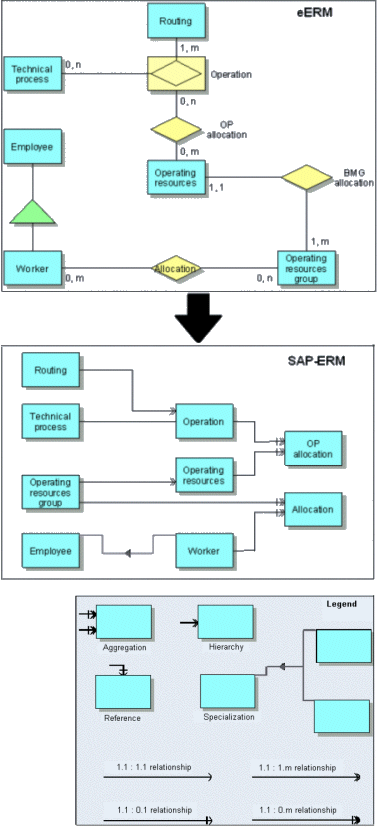SAP® SERM
Besides the representation form described here, other ERM representations are also in use. Frequently, relationship types are not represented as individual objects, but as connections between entity types. Relationship types that have their own attributes are then represented as (weak) entity types.
One such form of representation is the SERM representation (Structured Entity Relationship Model) developed by Sinz (see Sinz, Entity Relationship Model, 1990). The data structure's direction of development becomes visible by displaying the original and dependent data objects using directed graphs and arranging the model objects from left (strong entity types) to right (weak entity types and relationship types). The connection anchor points are restricted by the relevant object and thus enhance visualization of the development direction. The main difference between SER models and the modeling based on the eERM method described so far lies in the graphical representation.
The modeling technique developed by SAP AG in Walldorf/Germany as part of its modeling methodology links the concepts of the SER approach with the eERM approach presented here (see Keller/Hechler, Information Model, 1991).
In this context, no graphic distinction is made between entity types and relationship types during object formation. The dependencies between information objects are expressed by the relationship complexity of the arrow representations. A distinction is made between hierarchical, aggregating, and referential relationships (see the following figure).
Hierarchical relationships define a unilateral existence dependency between information objects.
Aggregating relationships correspond to the formation of relationship types based on the eERM approach.
Referential relationships describe logical dependencies between reinterpreted entity types and original entity types based on the eERM approach.
Specialization is represented in analogy to the ERM approach.
The following figure explains this notation by showing an example of the eERM representation being converted into the SAP® ERM representation (see also: Seubert, SAP® data model, 1991, p. 94).
This clearly shows that the fundamental technical content can be transferred to this form of representation without any loss of information.
The SAP® ERM may be considered as a representation of data models after the creation process has been completed. Due to the graph-oriented arrangement of information objects in the SAP® ERM, faster navigation and orientation is supported, particularly in larger data models.

